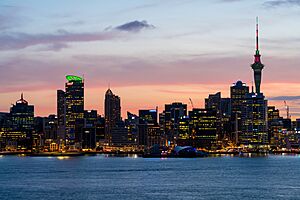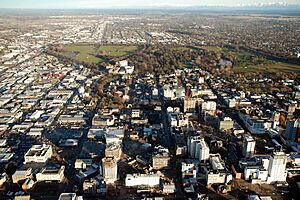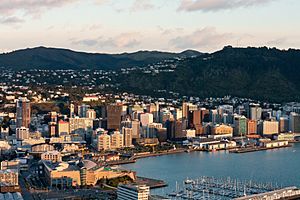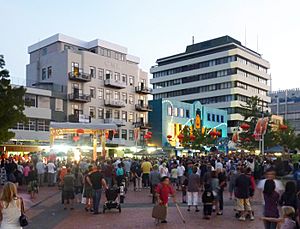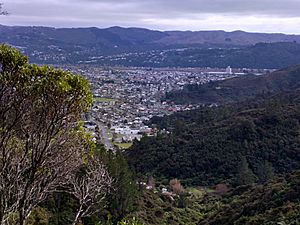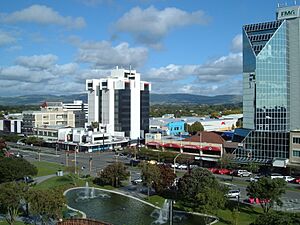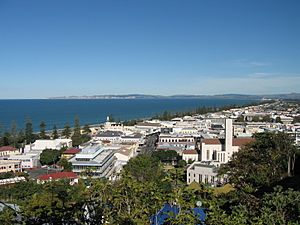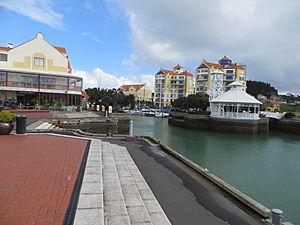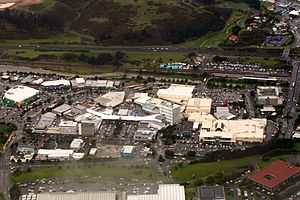List of cities in New Zealand facts for kids
In New Zealand, the word city can mean two different things. Before 1989, a town with 20,000 or more people could be called a city. The city's borders usually matched where people lived.
In 1989, New Zealand changed how its local governments worked. Most new district and city councils became much larger. They covered both urban and rural areas. Many places that used to have a "city council" are now run by a "district council". Since 2002, an urban area needs at least 50,000 residents to be officially called a city.
The word city is also used in a general way. It describes large urban areas of New Zealand, no matter what their local government is called. For example, Gisborne is governed by a "district council". But people still call it a city. Auckland also does not have a "city council". However, everyone agrees it is a city because of its huge size.
Below are the large urban areas often called "cities".
Contents
New Zealand's Urban Areas by Population
How Urban Areas Are Counted
Statistics New Zealand sets rules for how population numbers are measured. In 2017, they updated these rules. This change affected Wellington the most. It was split into four smaller urban areas. These include Wellington city and Lower Hutt city. Porirua and Upper Hutt became "large urban areas". Because of this, Wellington's population size was nearly cut in half. Lower Hutt then joined the top city rankings.
The table below shows all "major urban areas" (100,000 or more residents). It also lists all "large urban areas" (30,000 to 99,999 residents). The next urban area expected to become "large" is Paraparaumu.
| Rank | Urban area | Population | Area (km2) |
Population density (per km2) |
Image |
|---|---|---|---|---|---|
| 1 | Auckland | 1,478,800 | 605.67 | 2,441.6 | |
| 2 | Christchurch | 384,800 | 294.43 | 1,306.9 | |
| 3 | Wellington | 215,200 | 112.71 | 1,909.3 | |
| 4 | Hamilton | 185,300 | 110.37 | 1,678.9 | |
| 5 | Tauranga | 161,800 | 141.91 | 1,140.2 | |
| 6 | Lower Hutt | 113,000 | 78.54 | 1,438.8 | |
| 7 | Dunedin | 106,200 | 91.16 | 1,165.0 | |
| 8 | Palmerston North | 82,500 | 77.05 | 1,070.7 | |
| 9 | Napier | 67,500 | 105.05 | 642.6 | |
| 10 | Hibiscus Coast | 63,400 | 48.39 | 1,310.2 | |
| 11 | Porirua | 60,900 | 61.19 | 995.3 | |
| 12 | New Plymouth | 59,600 | 74.79 | 796.9 | |
| 13 | Rotorua | 58,900 | 46.06 | 1,278.8 | |
| 14 | Whangārei | 56,900 | 63.53 | 895.6 | |
| 15 | Nelson | 51,900 | 54.69 | 949.0 | |
| 16 | Hastings | 51,500 | 26.29 | 1,958.9 | |
| 17 | Invercargill | 51,000 | 62.95 | 810.2 | |
| 18 | Upper Hutt | 45,400 | 51.16 | 887.4 | |
| 19 | Whanganui | 42,800 | 41.05 | 1,042.6 | |
| 20 | Gisborne | 38,200 | 37.43 | 1,020.6 |
Functional Urban Areas (Metropolitan Areas)
Functional urban areas (FUAs) are larger regions. They include a main urban area and nearby towns. People often travel from these towns to the main urban area for work or school. These are also known as metropolitan areas.
The FUA populations below are from the 2018 Census.
| Rank | Urban area | Population | Area (km2) |
Urban areas included |
|---|---|---|---|---|
| 1 | Auckland | 1,574,619 | 3,358.8 | Auckland, Hibiscus Coast, Pukekohe, Beachlands-Pine Harbour, Clarks Beach, Helensville, Kumeu-Huapai, Maraetai, Muriwai, Parakai, Patumāhoe, Pōkeno, Riverhead, Tuakau, Waimauku, Waiuku |
| 2 | Christchurch | 470,814 | 2,408.1 | Christchurch, Kaiapoi, Rangiora, Rolleston, Diamond Harbour, Leeston, Lincoln, Lyttelton, Pegasus, Prebbleton, West Melton, Woodend |
| 3 | Wellington | 414,033 | 1,754.9 | Wellington, Lower Hutt, Porirua, Upper Hutt, Featherston, Greytown |
| 4 | Hamilton | 198,957 | 1,412.7 | Hamilton, Ngāruawāhia |
| 5 | Tauranga | 156,096 | 790.2 | Tauranga, Ōmokoroa |
| 6 | Dunedin | 125,007 | 1,033.8 | Dunedin, Mosgiel, Brighton, Waikouaiti |
| 7 | Palmerston North | 92,004 | 978.2 | Palmerston North, Ashhurst |
| 8 | Whangārei | 84,117 | 1,433.7 | Whangarei, Hikurangi, Ngunguru, One Tree Point, Ruakākā |
| 9 | Nelson | 79,998 | 1,177.2 | Nelson, Richmond, Brightwater, Hope, Māpua, Wakefield |
| 10 | New Plymouth | 79,074 | 920.9 | New Plymouth, Inglewood, Ōakura, Waitara |
| 11 | Hastings | 75,255 | 1,160.4 | Hastings, Havelock North, Clive |
| 12 | Rotorua | 67,179 | 649.1 | Rotorua, Ngongotahā |
| 13 | Napier | 64,767 | 260.0 | Napier |
| 14 | Invercargill | 54,084 | 428.5 | Invercargill |
| 15 | Kāpiti Coast | 46,683 | 317.4 | Paraparaumu, Waikanae, Paekākāriki |
| 16 | Whanganui | 44,403 | 598.1 | Whanganui |
| 17 | Gisborne | 39,447 | 612.8 | Gisborne |
City Councils in New Zealand
Current City Councils and Their Populations
The populations listed are the most recent estimates from Statistics New Zealand.
| Rank | City council | Population | First proclaimed |
|---|---|---|---|
| 1 | Auckland | 1,618,400 | 1871 |
| 2 | Christchurch | 380,200 | 1868 |
| 3 | Wellington | 209,000 | 1870 |
| 4 | Hamilton | 165,900 | 1936 |
| 5 | Tauranga | 140,800 | 1963 |
| 6 | Dunedin | 130,500 | 1865 |
| 7 | Lower Hutt | 107,600 | 1941 |
| 8 | Palmerston North | 87,300 | 1930 |
| 9 | Napier | 64,100 | 1950 |
| 10 | Porirua | 58,200 | 1965 |
| 11 | Invercargill | 55,800 | 1930 |
| 12 | Nelson | 52,400 | 1874 |
| 13 | Upper Hutt | 45,300 | 1966 |
Many cities were changed into districts in 1989. This happened under the Local Government Act 1974. For example, Timaru is no longer officially a city. Some urban areas like Rotorua and Whangārei are not cities anymore. However, they have more people than some places that are still called cities.
Tauranga is the most recent city to be officially named a city again. This happened on March 1, 2004. It had been a city before. Christchurch and Invercargill have also been declared cities more than once.
To become a new city today, a district must follow rules from the Local Government Act 2002. It needs at least 50,000 people. It must be mostly urban and a main center of activity in its region. Tauranga City Council is the only new city council created under these rules so far.
In 1991, the Lower Hutt City Council changed its name to Hutt City Council. However, the city itself is still called Lower Hutt.
History of New Zealand Cities
Before 1876, there was no clear rule for what made a place a city in New Zealand. So, it's a bit tricky to say which settlement was the very first city.
Royal Recognition
In the United Kingdom, a place usually became a city if the monarch granted it special "city status". This was often done with a special document called letters patent. Historically, cities often had a main church called a cathedral.
In 1841, the first church region (diocese) was set up in Auckland. But Auckland was never officially granted city status by the Queen. Later, in 1856, the church region of Christchurch was formed. Queen Victoria then officially made Christchurch a city with letters patent. Nelson was the only other city to get this special royal recognition in 1858.
Early Use of "City" in Elections
In 1852, the Governor of New Zealand, George Grey, set up areas for voting. He called one voting area the "City of Auckland". This was the first time "city" was used in New Zealand law. Soon after, the voting area for Wellington was also sometimes called "City of Wellington".
First City Councils
The very first local government to be called a "city council" was the Auckland City Council. It was set up in 1854. However, it was closed down in 1856. A new Auckland City Council was started in 1871. This council later joined to form the Auckland Council in 2010.
The Christchurch City Council was formed in 1863. It has been running ever since. This makes it the longest continuously operating city council in New Zealand.
Dunedin also has a special claim. Its city council was formed in 1865. There were some legal issues, so the central government had to step in. This made Dunedin City Council the first council recognized by central government law. Because of how the laws were written, Dunedin City Council can claim to have used the title "city council" without interruption for the longest time.
Who Was First? A Summary
Here's a quick look at the different claims for New Zealand's first city:
| Date | City | Reason for claim |
|---|---|---|
| 1839 | Wellington | First of New Zealand's modern cities to be settled |
| 21 May 1852 | Auckland | First time "City of Auckland" was used for a voting area |
| 6 February 1854 | Auckland | First city council was established (but it closed in 1856) |
| 31 July 1856 | Christchurch | First settlement to get official city status from the Queen |
| 31 January 1863 | Christchurch | Has the longest continuously operating city council |
| 18 May 1865 | Dunedin | Has the longest continuous use of the title "city council" |
Cities from 1877 to 1989
From 1886, a place was called a city if it was a borough with 20,000 or more people. This number was raised to 50,000 in 1989.
Before October 1989, many cities were changed. Some joined larger cities, and some became districts. Even if they are now districts, many New Zealanders still think of these places as cities. Here is a list from around 1986:
- North Island
- Whangārei (1964)
- Auckland
- Auckland (1871)
- East Coast Bays
- Takapuna
- Birkenhead
- Waitemata (1974)
- Mt Albert
- Papatoetoe
- Manukau (1965)
- Papakura
- Tamaki
- Hamilton (1936)
- New Plymouth (1949)
- Tauranga (1963) (lost city status 1989, regained 2004)
- Rotorua (1962, merged into Rotorua District, 1979)
- Gisborne (1955)
- Napier (1950)
- Hastings (1956)
- Wanganui (1924) (merged with surrounding counties to become Whanganui District, 1989)
- Palmerston North (1930)
- Wellington
- Wellington (1870)
- Upper Hutt (1966)
- Lower Hutt (1941)
- Porirua (1965)
- South Island
- Nelson (1874)
- Christchurch (1868)
- Timaru (1948)
- Dunedin (1865)
- Invercargill (1930)
Images for kids
See also
- List of statistical areas in New Zealand
- List of functional urban areas in New Zealand
- List of towns in New Zealand
- List of cities in Oceania by population
- List of New Zealand urban areas by population
- Territorial authorities of New Zealand
- List of cities and towns in the South Island
- List of cities and towns in the South Island by population


